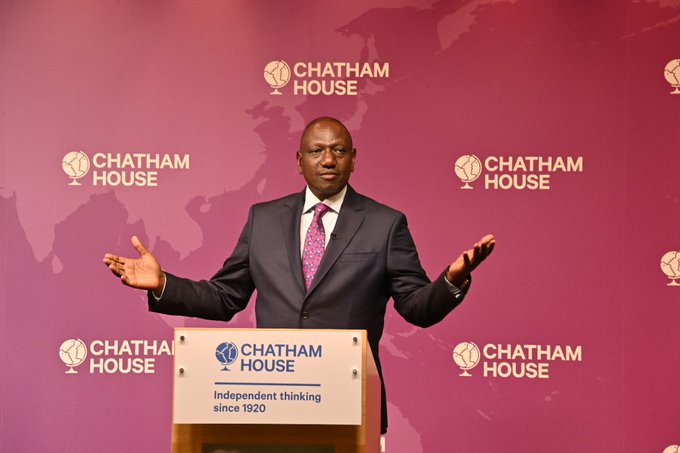Fact-checking Deputy President William Ruto’s 2022 Chatham House speech - Africa Check

DP Ruto speaking at Chatham House, London on March 7, 2022

Audio By Vocalize
William Ruto was back to a favoured stomping ground in the English capital. But did his claims on the day add up?
Kenya’s Deputy President William Ruto in early March 2022 returned to Chatham House, the British think tank, to articulate his agenda should he be elected president in five months' time.
Ruto outlined his development priorities and also responded to questions from the audience, including about his record in office. He has been the country’s second in command since 2013.
We checked nine claims he made, including on constitutional amendments, trade, agriculture and unemployment.
(Note: Ruto’s expected main rival, Raila Odinga, is also set to speak at the think tank. We will also monitor his speech for claims.)
Claim: “The building bridges initiative proposed about 72 different amendments to the constitution.”
Verdict: Mostly correct
We have contacted the Deputy President’s office for the evidence for his claims and we will update this report when we hear back.
In London, Ruto said the building bridges initiative, a government-backed bid to change the country’s 2010 constitution, had “proposed a raft of amendments in the region of 72 different amendments”.
The draft law to amend the constitution was published in November 2020. Kenya’s High Court and Court of Appeal subsequently ruled that the bill was unconstitutional. The government is awaiting the verdict on its appeal to the Supreme Court.
So how many amendments were proposed in the bill?
"To find out this, you have to check the clauses that propose specific changes to articles of the constitution," Victor Kapiyo, a partner at Nairobi law firm Lawmark Partners LLP, told Africa Check.
The bill to amend the constitution had 74 clauses, of which 71 propose amendments to various articles of the constitution.
We therefore rate this claim mostly correct. — Tess Wandia
Claim: “Four million of our young people …[are] out of school, out of college, out of university, have no jobs.”
Verdict: Exaggerated
Ruto said his “inclusive economic model” would create jobs for “millions” of Kenyans who have no work.
“Four million of our young people [are] out of school, out of college, out of university, have no jobs,” he said.
Labour statisticians at the Kenya Bureau of Statistics directed us to their quarterly labour force surveys. The most recent covers January to March 2021.
Published in September 2021, it gave the results of “the youth aged 15 – 34 who were not in the education system and were not working or being trained for work (NEET) during the reference period”.
Data collection is done over three months for 12 days each month. (Note: The agency said vocational training was not captured, “so, some of the youth might still be in training”.)
Kenya’s constitution defines “youth” as people who “have attained the age of eighteen years; but have not attained the age of thirty-five years”.
The survey found that of a total of 17.7 million young people, three million aged between 15 and 34 years fell into this category.
When the 15 to 24 age group is considered, the number of those excluded from the labour market was 1.7 million.
The World Bank counts this as those aged 15 to 29. This captures 2.5 million young Kenyans. But none of these numbers support the Deputy President’s figure.
The development lender says the “NEET group is particularly at risk of both labour market and social exclusion, because this group is neither improving their future employability through investment in skills nor gaining experience through employment.” — Makinia Juma.
Claim: “80% of all our business is in the space of micro, small and medium enterprise.”
Verdict: Unproven
Micro, small and medium-sized enterprises were key to his economic plan, Ruto said, giving this as “80% of all our business”.
"These businesses have up to 99 employees. The National Statistics office did not have data on the total business in the country," Robert Nderitu, its head of production statistics, told Africa Check.
"The most recent data is the 2016 micro, small and medium enterprise survey," Nderitu said. This cited the absence of a national business register as a shortcoming.
President Uhuru Kenyatta made the same claim in March 2020. We found it unproven when we fact-checked due to the absence of data.
We have not found any new data to change that verdict. —Alphonce Shiundu
Claim: “Today 15 million Kenyans are blacklisted on credit reference bureau.”
Verdict: Unproven
In November 2021 the Business Daily reported that as of January 2021, 14 million Kenyans were negatively listed by credit reference bureaus.
This means they could struggle to access credit or negotiate favourable terms.
The newspaper referred us to the Credit Information Sharing (CIS), which works with Kenya’s three licensed credit reference bureaus, as the source of this figure.
Jared Getenga, CIS chief executive, told Africa Check to check with the country’s regulator. “The data is with the Central Bank,” he said.
A top central bank official promised to share the data. We will update this report with the numbers.
In the absence of this we can only rate Ruto’s claim as unproven.—Makinia Juma
Claim: “15 million Kenyans … is actually half our working population.”
Verdict: Mostly correct
Ruto added that the number of people negatively listed with credit reference bureaus, which he gave as 15 million, is “actually half” of the “working population” in Kenya.
The working age population refers to the total number of potential workers within an economy. The national data agency gives this as the population that is between the ages of 15 to 64.
Another related term, the labour force, “consists of all persons in the working age population who are either employed or unemployed.”
According to the most recent labour survey, there are 28 million people aged 15 to 64. While we could not establish if 15 million Kenyans are negatively listed, the deputy president’s figure still comes close to half of the working age population. —Makinia Juma
Claim: “25% of our GDP is contributed to by agriculture.”
Verdict: Exaggerated
As he pledged massive investments in agriculture to boost employment and food security, Ruto claimed agriculture contributes one-quarter of Kenya’s gross domestic product or GDP.
A country’s GDP is the measure of the size of its economy. It is the market value of all goods and services produced in a country in a given period, usually a year.
Agriculture, specifically the growing of crops, animal production and other support activities, contributed 18.8% to Kenya’s GDP in 2019. This is according to the statistics bureau’s most recent economic survey.
The agency estimates this share to have risen to 20.4% in 2020.
When combined with fishing, fish-farming and forestry, the share rose to 21.2% in 2019 and a provisional 23% in 2020.
Ruto’s figure is at least two percentage points - or about KSh200 billion - off the mark. We therefore rate it exaggerated. —Alphonce Shiundu
Claim: “[Kenya] is the largest producer of milk in the continent. We produce five billion litres of milk.”
Verdict: Mostly correct
Increasing the productivity of dairy cattle could “turn around the fortunes” of dairy farmers, Ruto said.
Eric Vall is a researcher at CIRAD, the french agricultural research centre for international development. He works with the Africa Milk project which seeks to increase milk production in four countries on the continent: Senegal, Burkina Faso, Kenya and Madagascar.
The most recent reliable data on the continent’s milk production was on the statistics portal of the Food and Agriculture Organization, Vall told Africa Check.
FAO is a United Nations agency that focuses on reducing hunger.
According to the portal, in 2020 Kenya produced 4.05 million tonnes of cow milk, second only to Ethiopia which had 4.7 million tonnes. However, in 2018 and 2019, Kenya was the continent’s leading producer of milk from cows.
While Ruto dwelt on the productivity of cows, his statement about milk production was not specific to cows. A look at milk production from cows, camels, sheep and goats shows that Kenya is the leading African producer, with over 5.5 million tonnes, or 5.5 billion litres in 2020.
The Kenya Dairy Board, a state agency that governs milk production and marketing, shows that total production of milk from cows, camels, goats and sheep was 5.5 billion litres, in 2019.
We therefore rate this claim mostly correct. —Alphonce Shiundu
Claim: “We import KSh180 billion worth of food items into Kenya.”
Verdict: Mostly correct
According to the Kenya Revenue Authority (KRA), to import means “to bring or cause to be brought into the partner states from a foreign country”.
To fact-check this, officials at the national statistics bureau directed Africa Check to their quarterly balance of payments report.
The most recent report has the value of imports for 2019, 2020 and the first three quarters of 2021. The data shows Kenya spent Ksh.183.95 billion in 2019 and Ksh.173.94 billion in 2020, when the pandemic slowed business.
In the first three quarters of 2021, the total is Ksh.155.42 billion at an average of Ksh.51.8 billion every quarter. At the same pace, the amount is likely to exceed Ruto’s estimate. We rate the claim mostly correct. —Grace Gichuhi
Claim: “Intra trade in East Africa is about either 18% or close to 20%”
Verdict: Incorrect
The East African Community (EAC) is a regional political and economic bloc with six partner states: Burundi, Kenya, Rwanda, South Sudan, Tanzania and Uganda.
Intra-trade in East Africa refers to the exports and imports within the community.
Lillian Kiarie, from the communications department at the East Africa Business Council directed us to the bloc’s most recent trade report.
The EABC is made up of private firms from across the member states.
The bloc’s total trade was valued at US$55.3 billion in 2019 and $51.9 billion in 2020, with intra EAC trade comprising $6.3 billion and $5.99 billion in 2019 and 2020 respectively.
As a percentage it works to 11.4% in 2019 and 11.5%. This claim is therefore incorrect.
However, intra-EAC exports do work out to 20% in 2019 and 18% in 2020. —Tess Wandia


Leave a Comment